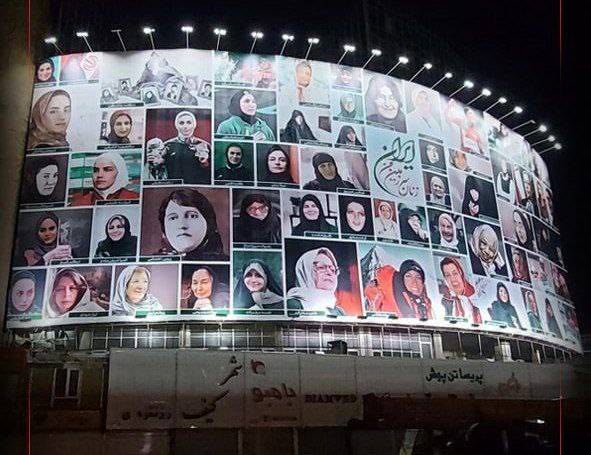Why the Controversial Billboard in Vali Asr Square Was Taken Down
The famous billboard in Vali Asr Square, which occasionally goes up for some reason and with a specific theme, did not last more than a day this time. A photo shared by a Twitter user late Thursday night showed the empty space where the billboard once stood.
Fatemeh Motamed-Arya, Jaleh Olov, and Marzieh Boroumand protested against the use of their images on a billboard titled ‘Women of My Land, Iran.’ Some of the figures on the billboard, who were mostly deceased, could not express their approval or disapproval. However, the impact and resonance of the few voices were so significant that it was likely to trigger a domino effect, causing other figures on the billboard to speak out. Therefore, keeping it up there was more of a liability than a benefit.
Reza Dormishian, a film director, also wrote that the image used of Jaleh Olov on the Vali Asr billboard was from a scene in the film ‘We Have to’ photographed by Noushin Jafari, who is currently in Evin Prison. As the director, producer, and owner of ‘We Have to,’ I do not consent to the misuse of my film’s image on the billboard installed in Vali Asr Square.
Supporters of Unveiling on the Vali Asr Billboard
The strange aspect of this mismatched billboard was the image of Bibi Khanum Astarabadi, a pioneering woman of the Constitutional Revolution era. Not only was her unveiled image, likely allowed on the billboard due to her old age, strange, but more importantly, it seemed the creators of the billboard had no familiarity with Bibi Khanum Astarabadi’s thoughts, ideas, and actions. She was the founder of the first girls’ school and a pioneer of unveiling in Iran.
Bibi Khanum Astarabadi’s significant work is a book titled ‘Defects of Men,’ which she wrote in response to the treatise ‘The Discipline of Women,’ criticizing the patriarchal views of the anonymous author of the latter. This book blends Islamic and Western perspectives on women, sometimes using a humorous tone and sometimes citing verses and hadiths, and is considered one of the first feminist manifestos in Iran. Parvin Etesami, whose image was also on the billboard, was a supporter of unveiling and even wrote a poem about it, which was removed from her collection in post-revolution editions.
The Implicit Message of the Vali Asr Billboard
If the streets are sporadically and uncoordinatedly taken over by protesters at night, supporters of the current discourse or conservative fundamentalists choose certain days for organized and coordinated marches. If nighttime protests lead to clashes, everything is safe and sound during the day.
If the city walls, especially in Tehran, become canvases for slogans and portraits of protest victims at night, using tools like stencils and spray paint, or if a simple banner with a handwritten slogan is hung from a pedestrian bridge on Hemmat Highway at midnight, the massive billboards are under the control of municipalities and other organizations where advertisements are installed during the day.
The Vali Asr billboard should also be evaluated and analyzed in this context: that the walls do not truly belong to the people and no one but us in Tehran has the right to install a billboard of this magnitude. That we still have the right to use women instrumentally; they are not autonomous subjects. Whenever we see fit, we can use them for promotional purposes according to our interests or perspectives. In essence, the main idea and perspective of this discourse is that these women are our assets or belongings, so we use them as we deem appropriate.
A kind of claim of ownership over individuals who, from a certain point onward, do not want to think like the ruling discourse. This claim has been repeatedly made by critics and protesters against celebrities or athletes who owe their current status to the existing structure. For some television celebrities, it has been repeatedly claimed that they gained fame and wealth thanks to the state media, and now they have bitten the hand that fed them.
Jafar Panahi once said about his film ‘Offside’ that in Iran, even the national team is considered the team of the Islamic Republic. Similar claims have been made regarding the wave of migration of elites and specialists, and sometimes they have even been labeled as traitors.
Why These Women
When the billboard went up, many questions were raised about it. Why were these women chosen among so many? What was the selection mechanism? What is the image of Forough Farrokhzad, whose thoughts are not only incompatible with the ruling ideology but are also antagonistic, doing there?
For example, why is there an image of a certain female athlete, but not of Leila Esfandiari? Why is there an image of Maryam Mirzakhani, but not Anousheh Ansari? Or why is Giti Khamenei included, but not Elaheh Rezai, and why is Iran Shaqoul, the news anchor of the 60s and 70s, not there, but Elmira Sharifi Moghaddam is? More importantly and interestingly, the exclusion of politically active women, especially from the opposing movement, on this large billboard was notable.
Whether politically active women before the revolution or after, another point was that the images of Forough Farrokhzad and Maryam Mirzakhani were both published with headscarves. This means that even when we want to tell you that these are the women of our land, we must fit them into our own standards and norms. The women of our land must be introduced in a way that we like or approve of.

